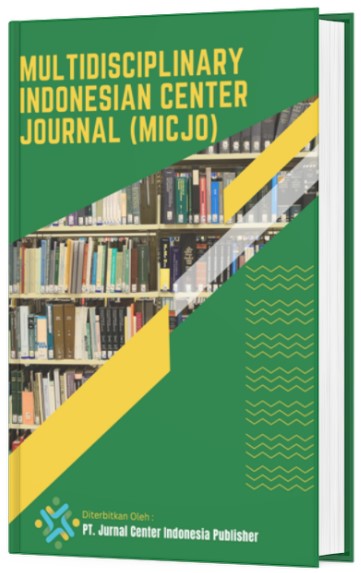WHEN WEIGHT DETERMINES CHILDBIRTH CHOICES: A DESCRIPTIVE STUDY OF OBESE PREGNANT WOMEN AT REGIONAL HOSPITAL DR. H. ABDUL MOELOEK OF LAMPUNG
DOI:
https://doi.org/10.62567/micjo.v2i3.1054Keywords:
Body Mass Index (BMI), delivery methods, maternal age, obesity, parity, pregnancyAbstract
Obesity in mothers is a major worldwide health issue that significantly raises the need for obstetric procedures, especially cesarean sections. Numerous difficulties for both mothers and newborns have been linked to elevated pre-pregnancy and gestational body mass indexes (BMI). The purpose of this study is to characterize the distribution of delivery methods among pregnant women who are obese at Dr. H. Abdul Moeloek Regional Hospital in Lampung Province, Indonesia. Total sampling was used to perform a quantitative, descriptive retrospective analysis. 58 pregnant women with a BMI of 30 kg/m² or above who gave birth between 2017 and 2023 were included. SPSS version 27.0 was utilized for data analysis. Findings out of the 58 instances that could be analyzed, 69.0% of obese pregnant women gave delivery via cesarean section, 27.6% gave birth spontaneous vaginally, and 3.4% had a vacuum induction. The majority (31.0%) were between the ages of 35 and 39, and 77.6% were multiparous. The type of delivery was found to be strongly influenced by maternal age, parity, and obesity. Being obese greatly raises the risk of having a cesarean section, especially for older and multiparous women. Reducing needless cesarean rates and improving mother and newborn outcomes may be possible with early treatments such as lifestyle modification education, prenatal counseling, and BMI-based risk assessment.
Downloads
References
Alsayegh, E., Bos, H., Campbell, K., & Barrett, J. (2018). No. 361—Caesarean delivery on maternal request. Journal of Obstetrics and Gynaecology Canada, 40(8), 967–971. DOI: https://doi.org/10.1016/j.jogc.2017.12.009
American College of Obstetricians and Gynecologists. (2024). Alliance for Innovation on Maternal Health (AIM). Available at: https://www.acog.org/practice-management/patient-safety-and-quality/partnerships/alliance-for-innovation-on-maternal-health-aim
Angolile, C. M., Max, B. L., Mushemba, J., & Mashauri, H. L. (2023). Global increased cesarean section rates and public health implications: A call to action. Health Science Reports, 6, e1274. DOI: https://doi.org/10.1002/hsr2.1274
Antoine, C., & Young, B. K. (2020). Cesarean section one hundred years 1920–2020: The good, the bad and the ugly. Journal of Perinatal Medicine, 49(1), 5–16. DOI: https://doi.org/10.1515/jpm-2020-0305
Brenes-Monge, A., Saavedra-Avendaño, B., Alcalde-Rabanal, J., & Darney, B. G. (2019). Are overweight and obesity associated with increased risk of cesarean delivery in Mexico? A cross-sectional study from the National Survey of Health and Nutrition. BMC Pregnancy and Childbirth, 19(1), 239. https://doi.org/10.1186/s12884-019-2393-5
CDC (Centers for Disease Control and Prevention). (2021). Overweight & obesity: Defining adult overweight and obesity. Available at: https://www.cdc.gov/obesity/basics/adult-defining.html
CDC (Centers for Disease Control and Prevention). (2024). Reduce cesarean births among low-risk women with no prior births—MICH‑06. Healthy People 2030. U.S. Department of Health and Human Services. Available at: https://health.gov/healthypeople/objectives-and-data/browse-objectives/pregnancy-and-childbirth/reduce-cesarean-births-among-low-risk-women-no-prior-births-mich-06
Cheney, K., Farber, R., Barratt, A. L., et al. (2018). Population attributable fractions of perinatal outcomes for nulliparous women associated with overweight and obesity, 1990–2014. Medical Journal of Australia, 208(3), 119–125.
Cochrane, L., Brumpton, K., Winter, S., Bell, K., Burnham, H., Wadwell, K., & Kitchener, S. (2019). Prevalence and outcomes of overweight and obesity among pregnant women in rural Queensland. Australian Journal of Rural Health, 27(2), 164–169. DOI: https://doi.org/10.1111/ajr.12495
Coelho, G. D. P., Ayres, L. F. A., Barreto, D. S., Henriques, B. D., Prado, M. R. M. C., & Passos, C. M. D. (2021). Acquisition of microbiota according to the type of birth: An integrative review. Revista Latino-Americana de Enfermagem, 29, e3446. DOI: https://doi.org/10.1590/1518.8345.4466.3446
Dalbye, R., Gunnes, N., Blix, E., et al. (2021). Maternal body mass index and risk of obstetric, maternal and neonatal outcomes: A cohort study of nulliparous women with spontaneous onset of labor. Acta Obstetricia et Gynecologica Scandinavica, 100, 521–530.
Declercq, E., MacDorman, M., Osterman, M., Belanoff, C., & Iverson, R. (2015). Prepregnancy obesity and primary cesareans among otherwise low-risk mothers in 38 U.S. states in 2012. Birth, 42(4), 309–318.
Dewi, R. S., Isfandiari, M. A., Martini, S., & Yi-Li, C. (2023). Prevalence and risk factors of gestational diabetes mellitus in Asia: A review. Journal of Public Health in Africa, 14(S2).
Driscoll, A. K., & Gregory, E. C. (2020). Increases in prepregnancy obesity: United States, 2016–2019. NCHS Data Brief, 392, 1–8.
Ellis, J. A., Brown, C. M., Barger, B., & Carlson, N. S. (2019). Influence of maternal obesity on labor induction: A systematic review and meta-analysis. Journal of Midwifery & Women's Health, 64, 55–67.
Fresch, R., Stephens, K., & DeFranco, E. (2024). The combined influence of maternal medical conditions on the risk of primary cesarean delivery. AJP Reports, 14, e51–e56. DOI: DOI: https://doi.org/10.1055/s-0043-1777996
Hajiahmadi, M., Shafi, H., & Delavar, M. A. (2015). Impact of parity on obesity: A cross-sectional study in Iranian women. Medical Principles and Practice, 24(1), 70–74. DOI: https://doi.org/10.1159/000368358
Hales, C. M., Carroll, M. D., Fryar, C. D., & Ogden, C. L. (2020). Prevalence of obesity and severe obesity among adults: United States, 2017–2018. NCHS Data Brief, 360, 1–8.
Hutcheon, J. A., & Bodnar, L. M. (2018). Good practices for observational studies of maternal weight and weight gain in pregnancy. Paediatric and Perinatal Epidemiology, 32(2), 152–160. DOI: https://doi.org/10.1111/ppe.12439
Institute of Medicine. (2009). Weight gain during pregnancy: Reexamining the guidelines. National Academies Press.
Jaacks, L. M., Vandevijvere, S., Pan, A., et al. (2019). The obesity transition: Stages of the global epidemic. The Lancet Diabetes & Endocrinology, 7, 231–240.
Krogh, L. Q., Glavind, J., Henriksen, T. B., Thornton, J., Fuglsang, J., & Boie, S. (2023). Full-term induction of labor vs expectant management and cesarean delivery in women with obesity: Systematic review and meta-analysis. American Journal of Obstetrics & Gynecology MFM, 5, 100909.
Lassiter, J. R., Holliday, N., Lewis, D. F., Mulekar, M., Abshire, J., & Brocato, B. (2016). Induction of labor with an unfavorable cervix: How does BMI affect success? Journal of Maternal-Fetal & Neonatal Medicine, 29(18), 3000–3002.
Leonard, S. A., Main, E. K., & Carmichael, S. L. (2019). The contribution of maternal characteristics and cesarean delivery to an increasing trend of severe maternal morbidity. BMC Pregnancy and Childbirth, 19, 16. DOI: https://doi.org/10.1186/s12884-018-2169-3
Li, W., Wang, Y., Shen, L., Song, L., Li, H., Liu, B., et al. (2016). Association between parity and obesity patterns in a middle-aged and older Chinese population: A cross-sectional analysis in the Tongji-Dongfeng cohort study. Nutrition & Metabolism, 13(1), 1–8. DOI: https://doi.org/10.1186/s12986-016-0133-7
Martínez-Hortelano, J. A., Cavero-Redondo, I., Alvarez-Bueno, C., Garrido-Miguel, M., Soriano-Cano, A., & Martínez-Vizcaíno, V. (2020). Monitoring gestational weight gain and prepregnancy BMI using the 2009 IOM guidelines in the global population: A systematic review and meta-analysis. BMC Pregnancy and Childbirth, 20, 649. DOI: https://doi.org/10.1186/s12884-020-03335-7
Maxwell, C., Gaudet, L., Cassir, G., Nowik, C., McLeod, N. L., Jacob, C.-É., et al. (2019). Guideline No. 392—Pregnancy and maternal obesity Part 2: Team planning for delivery and postpartum care. Journal of Obstetrics and Gynaecology Canada, 41(12), 1660–1675. DOI: https://doi.org/10.1016/j.jogc.2019.03.027
Ogunwole, S. M., Zera, C. A., & Stanford, F. C. (2021). Obesity management in women of reproductive age. JAMA, 325(5), 433–434. DOI: https://doi.org/10.1001/jama.2020.21096
Onubi, Ojochenemi J., Marais, Debbi., Aucott, Lorna., Okonofua, Friday., Poobalan, Amudha S. (2015). Maternal obesity in Africa: a systematic review and meta-analysis. Journal of Public Health, 38(3), e218–e231, fdv138–. DOI: 10.1093/pubmed/fdv138
Rogers, A. J. G., Harper, L. M., & Mari, G. (2018). A conceptual framework for the impact of obesity on risk of cesarean delivery. American Journal of Obstetrics and Gynecology, 219(4), 356–363. https://www.sciencedirect.com/science/article/pii/S0002937818304939
Ruhstaller, K. (2015). Induction of labor in the obese patient. Seminars in Perinatology, 39(6), 437–440.
Sagi-Dain, L. (2021). Obesity in pregnancy: ACOG practice bulletin, number 230. Obstetrics & Gynecology, 137 (6), e128–e144. DOI: https://doi.org/10.1097/AOG.0000000000004527
Santos, S., Voerman, E., Amiano, P., et al. (2019). Impact of maternal body mass index and gestational weight gain on pregnancy complications: An individual participant data meta-analysis of European, North American and Australian cohorts. BJOG: An International Journal of Obstetrics & Gynaecology, 126(8), 984–995.
TNSA (Türkiye Nüfus ve Sağlık Araştırması). (2018). 2018 Nüfus ve Sağlık Araştırması. Available at: http://www.hips.hacettepe.edu.tr/tnsa2018/rapor/20
TÜİK (Türkiye İstatistik Kurumu). (2019). Türkiye Sağlık Araştırması 2019. Available at: https://data.tuik.gov.tr/Bulten/Index?p=Turkiye-Saglik-Arastirmasi-2019-33661
Tzadikevitch‐Geffen, K., Melamed, N., Aviram, A., Sprague, A., Maxwell, C., Barrett, J., et al. (2021). Neonatal outcome by planned mode of delivery in women with a body mass index of 35 or more: A retrospective cohort study. BJOG: An International Journal of Obstetrics & Gynaecology, 128(5), 900–906.
Vitner, D., Harris, K., Maxwell, C., & Farine, D. (2019). Obesity in pregnancy: A comparison of four national guidelines. Journal of Maternal-Fetal & Neonatal Medicine, 32(15), 2580–2590. DOI: https://doi.org/10.1080/14767058.2018.1440546
Walędziak, M., & Różańska-Walędziak, A. (2022). Does obesity influence women’s decision-making about the mode of delivery? Journal of Clinical Medicine, 11(24), 7234. DOI: https://doi.org/10.3390/jcm11247234
WHO (World Health Organization). (2022, March 4). World Obesity Day 2022: Accelerating action to stop obesity. Available at: https://www.who.int/news/item/04-03-2022-world-obesity-day-2022-accelerating-action-to-stop-obesity
Downloads
Published
How to Cite
Issue
Section
License
Copyright (c) 2025 Juwita Desri Ayu, Sugiarto

This work is licensed under a Creative Commons Attribution-ShareAlike 4.0 International License.


















